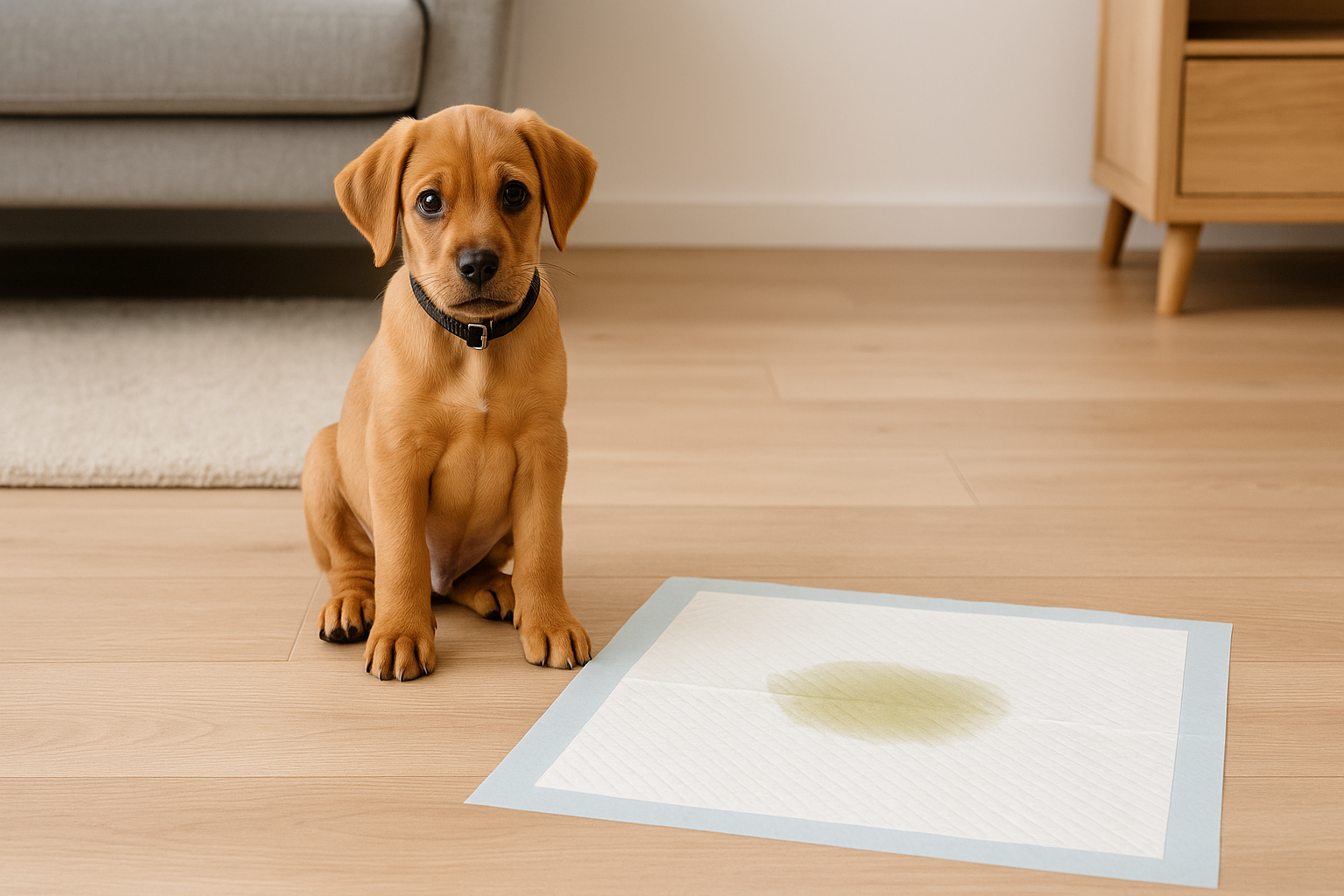
How to Potty Train a Puppy: The Complete Guide for New Dog Owners
Potty training a puppy is one of the most crucial early steps in creating a well-adjusted, happy dog. It’s also one of the biggest challenges new dog owners face. If you’re bringing home a new puppy, learning how to properly potty train a puppy is key to keeping your home clean and your dog healthy and stress-free.
In this guide, we’ll break down everything you need to know: when to start, how puppies learn, step-by-step methods, what to do when accidents happen, and how to know when it’s time to call in a professional. Let’s get into it.
Why Potty Training Matters
Teaching your puppy where to go and where not to go isn’t just about avoiding messes. Potty training sets the foundation for all future obedience and reinforces your role as a calm, consistent leader. It also helps your puppy feel secure and structured in their new environment.
A dog that doesn’t understand where to relieve themselves is more likely to become anxious, confused, or even ill from holding it too long.
When Should You Start to Potty Train a Puppy?
The best time to start potty training is as soon as your puppy comes home—ideally around 8 weeks of age. At this stage, they’re capable of learning routines, even if they don’t yet have full bladder control. Don’t wait for problems to start. Prevention is far more effective than correction.
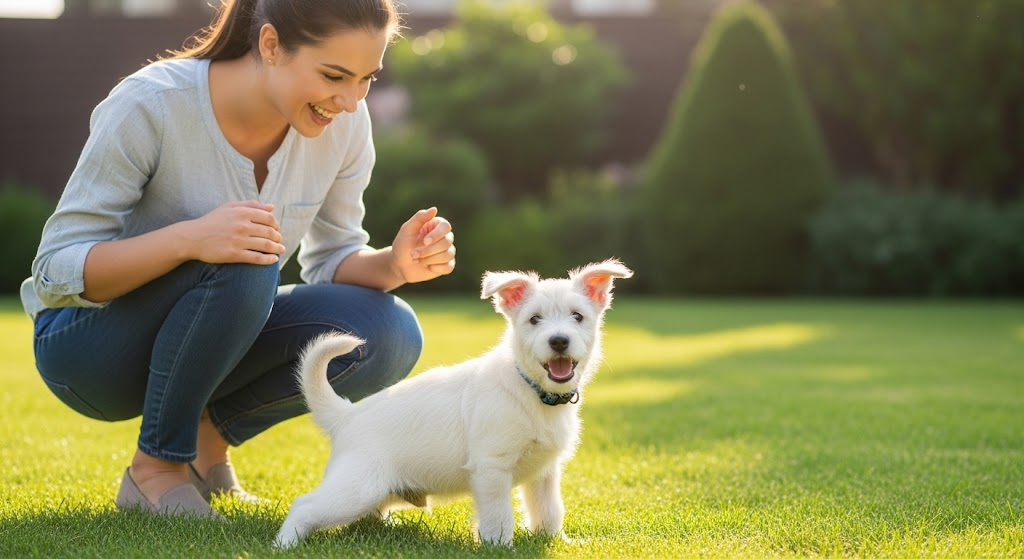
Understanding Your Puppy’s Mind and Body
How Puppies Learn
Puppies learn through repetition and consequence. Every time they perform an action and get a consistent result, their brain makes a connection. If they relieve themselves outside and receive praise or treats, they’re more likely to repeat that behavior. If they have an accident indoors and nothing changes, they won’t know it’s wrong.
Puppy Bladder Control by Age
Bladder control varies with age:
- 8-10 weeks: Can hold it for 30–60 minutes
- 11-14 weeks: Can hold it for 1–2 hours
- 15-20 weeks: Up to 3–4 hours
- 6+ months: May go 6+ hours
Nighttime will always require longer intervals, but consistent daily routines shorten the training curve.
Signs Your Puppy Needs to Go
Learn to spot early signs like:
- Circling or sniffing the floor
- Whining or pacing near a door
- Barking suddenly
- Returning to a previously soiled spot
Prompt action can prevent an accident.
Potty Training Essentials for Puppies
What You’ll Need
- A properly sized crate (not too big, not too small)
- Leash and collar
- Puppy-safe enzymatic cleaner for accidents
- High-reward training treats
- Puppy pads (optional, for certain living situations)
Set a Potty Schedule
Dogs thrive on structure. Your puppy should be taken out:
- First thing in the morning
- After every meal or drink
- After naps or playtime
- Every 1–2 hours during the day
- Right before bedtime
Using the same exit door and route each time also reinforces the routine.
Pick a Designated Potty Spot
Consistency is key. Always take your puppy to the same outdoor area to do their business. Let them sniff and explore a bit, but don’t play with them until after they’ve gone.
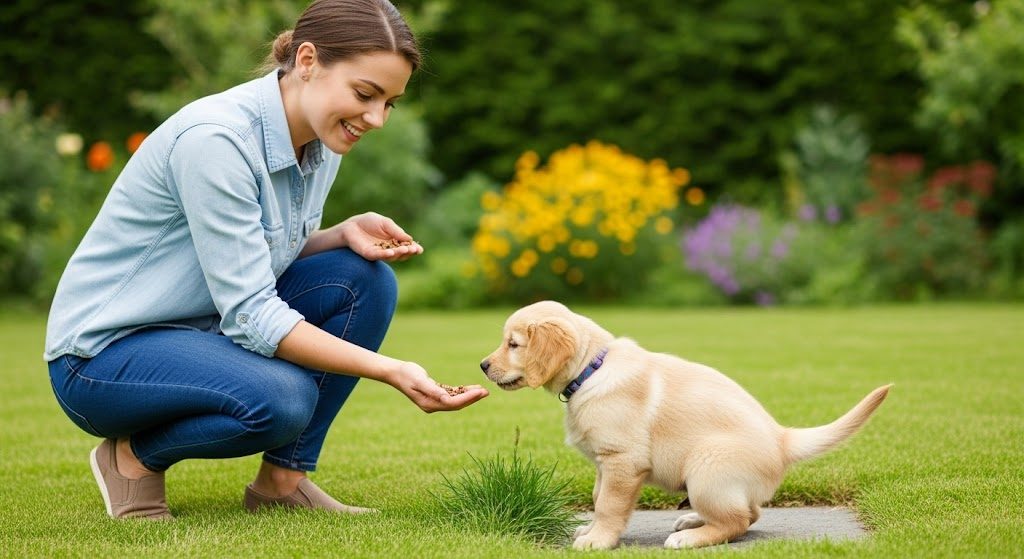
Step-by-Step Puppy Potty Training Method
Step 1: Crate Training
Dogs are naturally clean animals and avoid soiling their sleeping area. Use a crate that’s just big enough for your puppy to stand, turn around, and lie down. Too much space allows them to potty on one end and sleep on the other.
Put your puppy in the crate when you can’t supervise them directly. This teaches them to hold it and wait to be let outside. Always take them out immediately after crate time.
Step 2: Using Consistent Verbal Cues (“Go Potty,” “Do Your Business”)
Say your chosen verbal cue just as your puppy is about to go or while they are going. This helps them associate the phrase with the act, eventually allowing you to cue them to go on command.
Step 3: Supervision
When your puppy isn’t in the crate, they should be within your line of sight. Use a leash to tether them to your belt or keep them in a confined area like a gated kitchen. Constant supervision means you can catch signs and act fast.
Step 4: Reinforce Good Behavior
When your puppy eliminates in the right spot, reward immediately with praise, petting, or a treat. Don’t wait until you’re back inside; they won’t connect the dots. Celebrate successes enthusiastically.
Step 5: Handle Accidents the Right Way
Accidents happen. If you catch your puppy in the act, interrupt with a gentle “uh-oh!” and take them outside immediately. Clean the mess thoroughly with enzymatic cleaner to remove odors that attract repeat offenses.
Step 6: Optional: Bell Training for Clear Communication
Some owners find bell training helpful. Hang a bell from the door your puppy uses to go outside. Gently guide your puppy’s paw to hit the bell before each potty trip. When they eventually ring the bell themselves to signal they need to go out, immediately take them.
Never yell or punish your puppy after the fact. They won’t understand why you’re upset, and fear can slow progress.
Common Potty Training Mistakes to Avoid
Steer clear of these common pitfalls that can prolong the potty training process.
- Inconsistency in Schedule and Routine: The biggest mistake. A fluctuating schedule confuses your puppy.
- Not Supervising Your Puppy Adequately: Unsupervised puppies are prone to accidents. Use leashes, tethers, or crates when you can’t actively watch them.
- Rushing the Process or Having Unrealistic Expectations: Potty training takes time and patience. Every puppy is different.
- Misusing Potty Pads (and Why They Can Hinder Progress): While useful in some specific situations, relying heavily on potty pads can make the transition to outdoor-only potty training more difficult, as your puppy learns it’s okay to eliminate indoors.
- Ignoring Your Puppy’s Potty Signals: Failing to recognize or act on your puppy’s cues will lead to more accidents.
Troubleshooting Common Potty Training Problems
Frequent Accidents Indoors
This is often due to a schedule that’s too loose. Tighten up outings and increase supervision. Reassess your puppy’s feeding and drinking habits as well.
Regression
It’s normal for puppies to take a few steps back during growth phases or changes in routine. When regression happens, return to basics: crate more often, praise successes, and supervise closely.
Marking vs. Accidents
Some dogs, especially males, may mark territory. This is different from potty accidents and may require neutering or behavioral intervention. Clean marked spots thoroughly and discourage access to those areas.
Anxiety Around Potty Time
If your puppy is scared to go outside, desensitize them gradually with calm walks, praise, and treats. Avoid rushing them or showing frustration.
Advanced Puppy Potty Training Tips
Living in an Apartment?
Use balcony turf pads or indoor grass patches temporarily, then gradually move them closer to the door and eventually outside. Make sure your puppy knows the difference between play and potty areas indoors.
Transitioning from Puppy Pads
If you’ve been using pads, slowly relocate them outdoors. Each day, move the pad closer to the door until it’s on the outside. Praise and reward each success.
Nighttime Training
Puppies under 12 weeks often need a nighttime potty break. Cut off water 2 hours before bed, take them out right before sleep, and set an alarm if necessary.
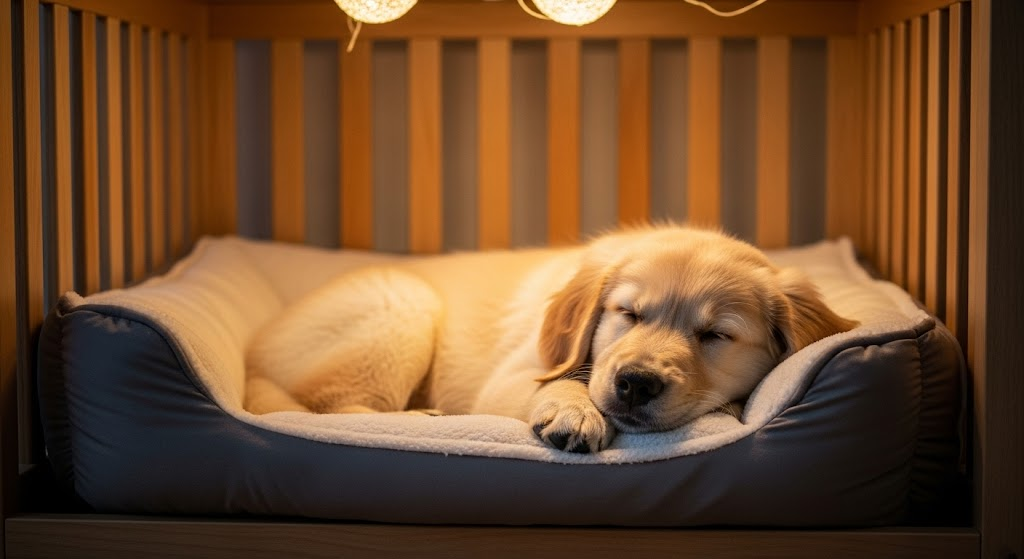
How Long Does It Take to Potty Train a Puppy?
Most puppies can be mostly potty trained by 4 to 6 months, but it depends on your consistency, their age, and even their breed. Smaller dogs may take longer due to smaller bladders. The key is patience and repetition. Here is a detailed guide on how long it takes to potty train your puppy.
When to Call in a Professional Trainer
If you’ve stuck to a routine and still see no progress, it might be time to call in help. Puppies that continue to have frequent accidents, show fear of going outdoors, or demonstrate behavioral challenges benefit greatly from professional evaluation and training support.
Why Dan Gentile Dog Training Center is Monmouth County’s Top Choice
At Dan Gentile Dog Training Center, we understand that every puppy is unique. Our expert team has over 30 years of experience helping families across Monmouth County and beyond raise obedient, house-trained, confident dogs.
Whether you need help with basic potty training, want a comprehensive training program, or are planning a trip and need someone to train your dog while you’re away, we’ve got you covered.
- Learn more about our Dog Training Programs.
- Discover our state-of-the-art Dog Training Center in New Jersey.
- Going away? Train your dog while you’re on vacation with us!
Your puppy deserves the best start. We’re here to help make that happen.
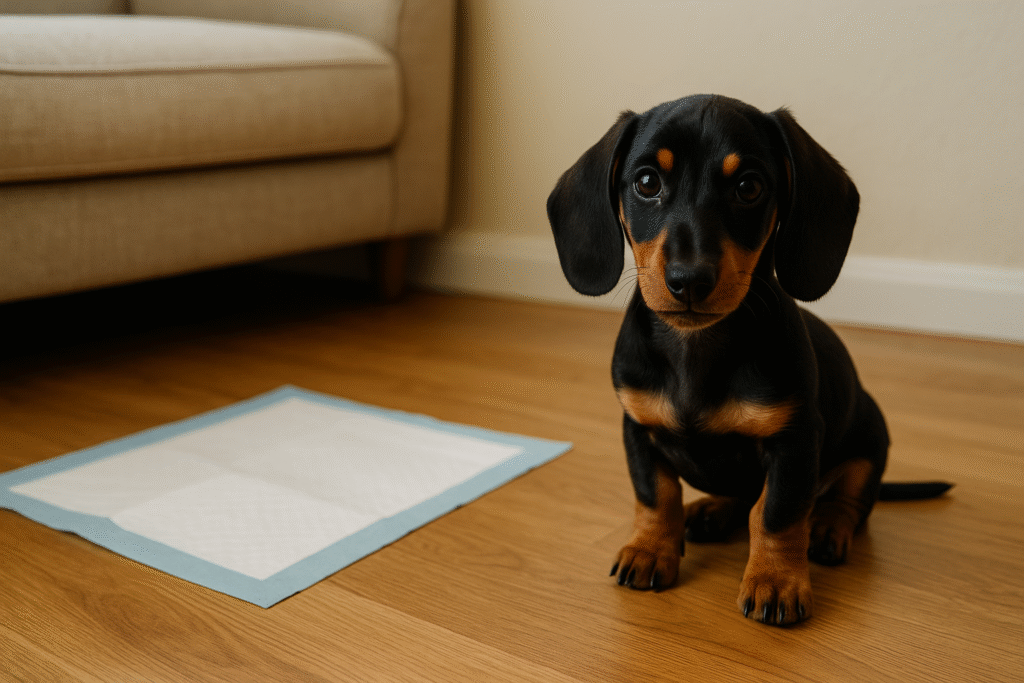
Frequently Asked Questions
What is the fastest way to potty train my puppy?
The fastest way to potty train your puppy is by combining crate training, a consistent schedule, and positive reinforcement. Take your puppy out every 1–2 hours, immediately after meals, naps, and playtime. Always bring them to the same outdoor spot and reward them with treats and praise right after they go. Use a crate to prevent accidents and reinforce holding behavior. Consistency, supervision, and patience are key to speeding up the process.
How long does it take to potty train a puppy?
On average, it takes 4 to 6 months to fully potty train a puppy, though some may catch on faster with consistent training. Small breeds may take longer due to smaller bladders. If you’re consistent with schedules, supervision, and rewards, most puppies show strong progress within the first few weeks. Full reliability usually develops by 6 months of age.
What is the 10 minute rule for potty training?
The “10 minute rule” refers to waiting about 10 minutes outside with your puppy to give them enough time to relieve themselves. If they don’t go within 10 minutes, bring them back inside and try again shortly. This method prevents outdoor play from becoming a distraction and keeps the focus on going potty first. Always reward them immediately after they go to reinforce the behavior.
How should I discipline my puppy for peeing in the house?
Never use punishment to discipline your puppy for peeing in the house. Yelling, hitting, or rubbing their nose in it creates fear and slows training. Instead, if you catch them in the act, interrupt gently with a word like “uh-oh” and take them outside. Clean the accident thoroughly with an enzymatic cleaner to remove scent cues. Focus on prevention, supervision, and rewarding correct behavior rather than punishment.
How do I stop my puppy from peeing when I get home?
If your puppy pees when you come home, they’re likely experiencing submissive urination or excitement urination. To stop it: Keep greetings low-key and calm. Avoid direct eye contact or overwhelming excitement. Take them outside immediately upon arriving home. Build their confidence with positive reinforcement and basic obedience training. This behavior often fades with age and confidence-building.
Are pee pads a good idea for puppies?
Pee pads can be helpful for temporary indoor training, especially in apartments or for very young puppies. However, they can also create confusion if you’re trying to teach your dog to go outside. If you use pads, be sure to gradually transition them toward the door and eventually to an outdoor potty spot. For long-term success, outdoor training with a consistent routine is the preferred method.
Final Thoughts
Potty training a puppy takes time, consistency, and a little patience but it pays off for a lifetime. Stick to a solid schedule, supervise closely, praise good behavior, and don’t be afraid to ask for help when needed. With the right foundation, your puppy will grow into a well-behaved and happy companion.
And if you’re in Monmouth County or anywhere in New Jersey, Dan Gentile Dog Training Center is your go-to partner for professional, proven puppy training support. Let’s build the bond between you and your dog the right way.